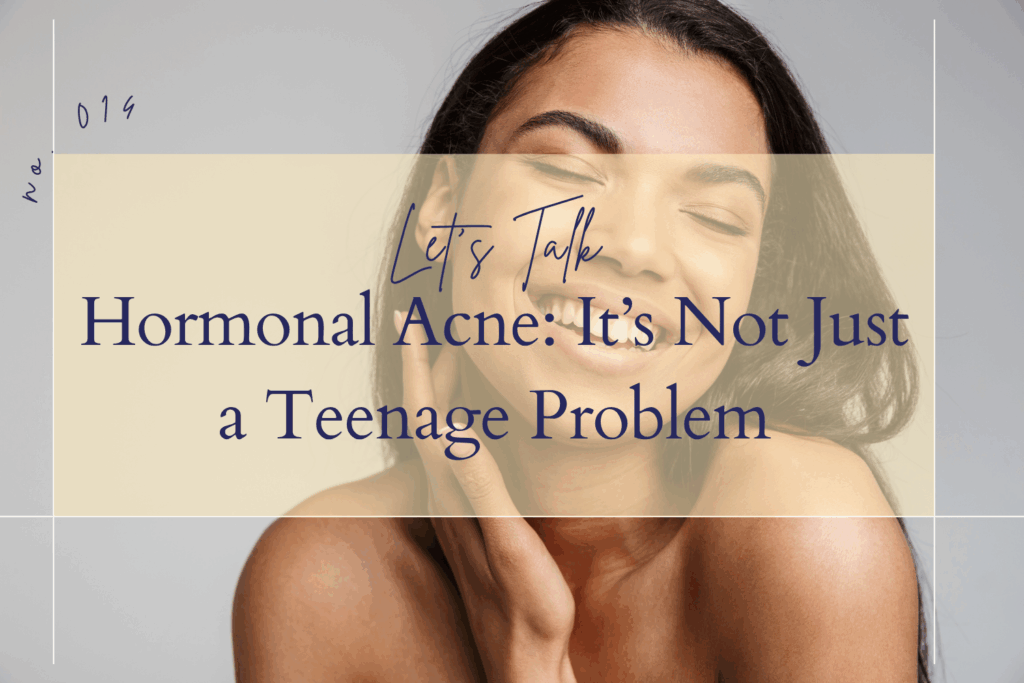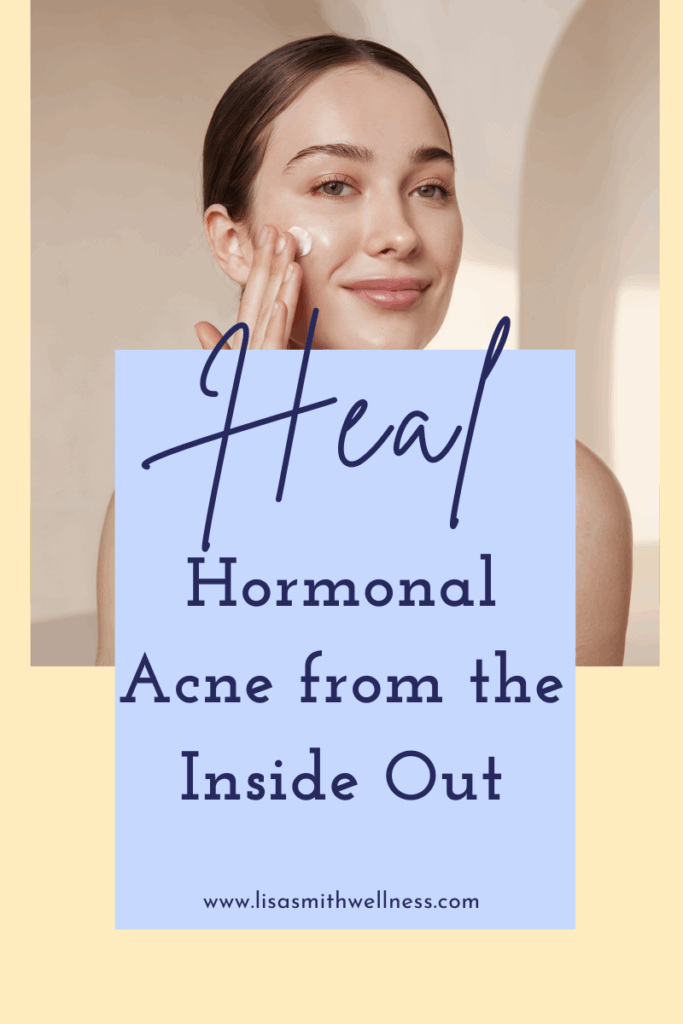Let’s have a real moment here and talk hormonal acne.
You’re doing everything right—eating clean (ish), washing your face, using the fancy serums with words you can’t pronounce, and steering clear of the pimple-popping side of TikTok (you’re welcome, lymphatic system). And yet… your skin has decided to throw a hormonal tantrum.
Hormonal acne is a different beast. And if you’ve ever felt personally victimized by your jawline in the week before your period (or honestly, all month long), this one’s for you.
Let’s break down what’s really happening under your skin—and what you can do to calm the hormonal chaos.
This post contains affiliate links meaning I make a small commission at no extra cost to you. Thank you for supporting the work of Lisa Smith Wellness and the Pretty Well Podcast!

So… What Exactly Is Hormonal Acne?
Think of hormonal acne as the overachiever of breakouts. It usually shows up around your chin, jawline, neck, or even your upper back—just to keep things spicy. It’s deep, cystic, and painful, often ignoring your $78 spot treatment like it’s completely unbothered.
Unlike your standard teenage T-zone breakouts, hormonal acne is driven by internal imbalances—primarily sex hormones like estrogen, progesterone, and testosterone.
Here’s the tea: For women, in the days leading up to your period, estrogen and progesterone drop while testosterone hangs around like the last guest at a party. This hormonal shift ramps up sebum (oil) production, clogs pores, and invites Cutibacterium acnes to the party (the bacteria formerly known as P. acnes). For guys, hormonal surges in testosterone cause the same frustrating symptoms.
Throw in a sluggish liver, a gut that’s more “confused” than helpful, and some chronic stress, and you’ve got yourself a breakout cocktail.
The Real Culprits Behind Hormonal Acne
Let’s stop blaming dirty pillowcases and start talking root causes. (Although, it’s never a bad idea to change those pillowcases every couple days). Anyway, here are the usual suspects:
1. Estrogen Dominance
No, it’s not just an issue of “too much estrogen.” Estrogen dominance often means not enough progesterone to balance things out. Low progesterone = more androgens (like testosterone) running wild = more oil, inflammation, and cystic breakouts.
Related Episode: #126 Seed Cycling, Does it Even Work?
2. Testosterone and Androgens
An uptick in androgens (including DHEA and DHT) increases sebum production and thickens the skin lining of your pores. It’s like they’re actively trying to trap bacteria in there.
3. Insulin Resistance
Blood sugar swings cause insulin to spike, which can trigger the ovaries (and adrenals) to pump out more androgens. Which—as we’ve now established—is acne’s BFF.
4. Stress (and the Cortisol Cascade)
You know that moment when someone cuts you off in traffic and your skin breaks out the next day? That’s cortisol whispering to your oil glands: “Let’s go rogue.” Chronic stress = chronically elevated cortisol = hormonal dysregulation = surprise breakouts.
5. Gut Imbalances
Your gut regulates estrogen through a collection of bacteria called the estrobolome. If that microbiome isn’t balanced, estrogen can recirculate in the body instead of exiting stage left. The result? Inflammation, impaired detox, and—yep—hormonal acne.
6. Liver Congestion
Your liver is responsible for metabolizing and clearing out hormones. If it’s overwhelmed by toxins, alcohol, medications, or ultra-processed foods, those hormones hang around longer than they should. Think of it like your liver’s inbox is full—and acne is the unread message.

What Hormonal Acne Isn’t
Let’s bust some myths, shall we?
- It’s not poor hygiene. If you’re washing your face twice a day and still breaking out, it’s not because you’re “doing it wrong.” Stop scrubbing like a kitchen sponge.
- It’s not just a teenage thing. Hormonal acne often rears its head in your 30s, 40s, and even 50s, especially during perimenopause when hormone shifts go full soap opera.
- It’s not always fixable with skincare. No serum, mask, or toner is going to balance your hormones. (That said, supportive skincare doesn’t hurt—just don’t expect miracles.)
How to Start Clearing Hormonal Acne (From the Inside Out)
1. Balance Your Blood Sugar
Step away from the oat milk brown sugar latte and gluten-free muffin. Keeping blood sugar stable keeps insulin (and androgens) in check.
Tips:
- Eat protein + fat at every meal.
- Don’t skip breakfast.
- Avoid naked carbs (carbs without a protein-rich buddy).
2. Love On Your Liver
Support phase 1 and 2 liver detox pathways so hormones get properly packaged and eliminated—not recycled like last season’s trends.
Tips:
- Eat cruciferous veggies (broccoli, cauliflower, arugula).
- Add milk thistle, dandelion root, or NAC (work with a practitioner – this one isn’t DIY).
- Drink plenty of water (bonus: fewer sugar cravings).
3. Heal the Gut
If your estrobolome is off, so is your estrogen clearance. A stool test can reveal microbial imbalances, candida, or dysbiosis that need to be addressed.
Tips:
- Add prebiotic fibers (like onions, garlic, chicory root).
- Incorporate fermented foods or high-quality probiotics.
- Ditch inflammatory foods (gluten, dairy, sugar, seed oils).
4. Manage Stress Like It’s Your Job
Because it kind of is. Especially if you want your skin and hormones to play nice.
Tips:
- Try daily breathwork, walking outside, or somatic practices.
- Get 7–9 hours of sleep. Yes, every night.
- Supplement with adaptogens (ashwagandha, rhodiola, holy basil—based on your needs).
5. Replenish Key Nutrients
Chronic stress and inflammation deplete the very nutrients your skin needs to thrive.
Key Players:
- Zinc: reduces inflammation and supports skin healing.
- Omega-3s: anti-inflammatory and hormone balancing.
- Vitamin A: supports cell turnover (note: too much = toxicity, so be wise).
- Magnesium: helps regulate cortisol and insulin.
Pin This for Later

Bonus Tips for Smart Skincare
If your skin is angry, treat it kindly. Avoid harsh exfoliants and a 9-step routine that only stresses it out more.
Do:
- Use a gentle, non-stripping cleanser.
- Look for non-comedogenic oils (squalane, jojoba).
- Support your barrier with niacinamide or ceramides.
Don’t:
- Pop deep cysts (you’ll regret it).
- Overuse actives like retinoids or acids.
- Skip sunscreen (you still need it, even indoors).
The TL;DR (but you read it, right?)
Hormonal acne is more than skin deep—literally. It’s a sign your internal systems (hormones, gut, liver, blood sugar) are out of sync. But that also means there’s a lot you can do to support your body and reclaim clear, healthy skin.
You don’t need another serum. You need strategy.
And if you’re not sure where to start? Start with food, stress, and poop. Yep, I said it. Poop. Your skin will thank you.
Final Thoughts
Acne in adulthood is frustrating, demoralizing, and sometimes downright infuriating. But it’s not random—and it’s not forever. By looking at your skin as a messenger (not a misbehaving child), you can start making changes that actually move the needle.
And remember: you are not your breakouts. You are not your worst skin day. You’re a whole, beautiful, multidimensional human who deserves to feel confident in your own skin—even if it’s currently holding a protest on your chin.
+ view comments . . .